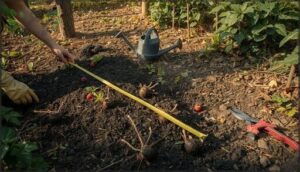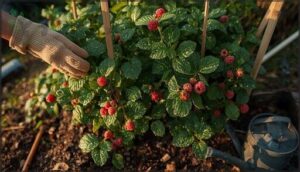This site is supported by our readers. We may earn a commission, at no cost to you, if you purchase through links.
Most gardeners don’t realize that a single raspberry plant can produce fruit for 15 years or more, quietly multiplying into a generous hedge that feeds your family every summer. Yet growing raspberries in home garden spaces intimidates many beginners who assume these delicate berries need expert-level skills or commercial equipment.
The truth is simpler: raspberries thrive with surprisingly little fuss once you understand a few biological basics about how they fruit and spread. Choose varieties that match your climate and pruning preferences, prepare soil that drains well, and you’ll harvest bowls of fresh berries within your first year—often enough to freeze, share, and still snack on warm fruit straight from the cane.
Table Of Contents
- Key Takeaways
- Choosing The Best Raspberry Varieties
- Preparing The Planting Site
- Planting and Supporting Raspberry Bushes
- Essential Raspberry Plant Care
- Harvesting and Maintaining Raspberry Plants
- Frequently Asked Questions (FAQs)
- Can you grow raspberries from your own plants?
- How do you grow raspberries in a garden?
- How far should you space raspberry plants?
- How do raspberries grow?
- Can you grow black raspberries in a home garden?
- How do you grow a red raspberry plant?
- Can raspberries grow in containers successfully?
- How long do raspberry plants typically live?
- When will new plants produce first harvest?
- Can different raspberry varieties cross-pollinate?
- Conclusion
Key Takeaways
- Raspberries can produce fruit for 15+ years with minimal maintenance once you match variety type (summer-bearing vs. ever-bearing) to your climate and choose well-draining soil with pH 5.5–6.5.
- Ever-bearing raspberries fruit on new growth and can be mowed to the ground annually for simpler pruning, while summer-bearing types produce on second-year canes and require selective removal after harvest.
- Proper spacing (2–3 feet between plants, 6–8 feet between rows) and support structures like wire trellises can boost yields by 10–20% while making maintenance and harvesting significantly easier.
- Consistent watering (1–1.5 inches weekly), organic mulching (2–4 inches deep), and early spring fertilization create the foundation for healthy plants that often produce harvestable fruit in their first year.
Choosing The Best Raspberry Varieties
Before you plant your first raspberry cane, you’ll need to choose the variety that works best for your garden and harvest goals. Raspberries come in different fruiting patterns and colors, each with unique growing habits and flavor profiles.
Let’s look at the main types you can grow and some reliable cultivars that perform well in home gardens.
Summer-bearing Vs. Ever-bearing Types
When you’re starting with raspberries, understanding the two main fruiting types will shape your entire growing experience. Summer-bearing (floricane-bearing) raspberries produce a single, concentrated crop in early to mid-summer on last year’s canes, while ever-bearing (primocane-bearing) raspberries fruit on new growth, delivering berries from late summer through frost. Floricane raspberries require trellising due to their tall, drooping canes.
Here’s what sets these types apart:
- Fruiting timeline: Summer-bearing varieties finish by early August, while ever-bearing types extend garden availability into fall—sometimes even producing two crops when double-cropped.
- Yield comparison: Fall-bearing raspberries in high tunnels average roughly 16% higher annual yields than summer types over a seven-year lifespan.
- Pruning differences: Ever-bearing canes can be mowed to the ground each year for simpler maintenance, whereas summer-bearing plants need selective cane removal after harvest.
- Climate suitability: Primocane-bearing raspberries handle disease pressure better and require less winter chilling, making them adaptable across more growing zones.
- Garden availability: Ever-bearing cultivars often fruit lightly in their first planting year, while summer-fruiting raspberries generally wait until year two to produce.
Red, Black, Purple, and Yellow Raspberries
Beyond fruiting habits, raspberry color type genetics lead to surprising diversity in your garden. Red raspberries dominate home plantings with strong yield growth habit—averaging 4,000 pounds per acre—while black raspberries produce half that but pack intense flavor. Purple raspberries blend both parents’ vigor, and yellow raspberries offer the same fruit size quality as reds minus the red pigment, showing comparable nutritional variation despite their pale appearance.
For best growth, consider using berry shelters for young raspberry plants.
Recommended Cultivars for Home Gardens
Choosing raspberry varieties isn’t guesswork—it’s matching plant to place. Here’s how to nail varietal selection for your home garden:
- Everbearing advantages shine in warm zones—’Caroline’ ripens 10–14 days before ‘Heritage’, avoiding late-season heat stress.
- Cold-hardy choices like ‘Boyne’ survive Zone 3 winters down to -34°C.
- Thornless options such as ‘Joan J’ deliver 3.32 kg per meter without the scratches.
- Regional favorites matter—’Polana’ thrives in high elevations, fruiting three weeks early.
- Pest resistance counts—early-ripening types dodge spotted wing drosophila pressure naturally.
Preparing The Planting Site
Getting your planting site ready is like setting the stage for a great performance—your raspberries can’t thrive without the right foundation. You’ll need to think about soil quality, sunlight exposure, how you’ll arrange your plants, and whether you’re working with garden beds or containers.
Let’s walk through each of these key preparation steps to give your raspberry bushes the best possible start.
Soil PH and Fertility Requirements
Think of your soil as the foundation of your raspberry harvest—getting the pH right matters. Aim for a preferred pH between 5.5 and 6.5; soil testing shows you where you stand. If pH adjustment is needed, lime raises it while sulfur lowers it.
Boost organic matter with compost before planting. For fertility timing, apply fertilizer in early spring when growth starts, focusing on macronutrient needs like nitrogen.
Sunlight and Air Circulation Needs
Your raspberries thrive with full sun—at least 6 hours daily, though 8 hours maximizes yield.
Good air circulation matters just as much; stagnant humidity invites gray mold and other fungal diseases. Choose a site with gentle airflow, avoiding low-lying pockets where moisture lingers.
Good air circulation prevents gray mold—choose sites with gentle airflow, avoiding low pockets where moisture lingers
Proper canopy management through pruning keeps foliage open, accelerating drying after rain. Wind protection helps, but don’t block airflow entirely—balance is key for disease prevention.
Selecting and Spacing Raspberry Plants
When selecting raspberry plants from a nursery, opt for certified virus-free dormant canes—healthy stock resists mosaic and other diseases that can plague your planting for years. Tissue culture varieties cost more but start cleaner. Remove wild brambles within 600 feet to cut virus transmission, and order one cultivar per row for row uniformity.
Key spacing recommendations for your site:
- Red raspberry varieties: 2–3 feet apart within rows, forming a manageable hedgerow
- Black and purple types: 3 feet apart or 6×6 feet in hills for arching canes
- Row centers: 6.5–8 feet apart for mower access and harvest ease
- Home yield: 4–5 plants per person supplies 1–2 quarts each season
Raised Beds and Container Planting
For tight spaces or heavy clay, raised beds and potted plants solve drainage headaches fast. Build beds 8 inches tall with well-draining soil—equal parts compost, potting mix, and perlite keeps roots happy. Containers need a 16-inch diameter minimum; dwarf varieties like Raspberry Shortcake thrive in 10-gallon pots.
Productivity benefits include earlier harvests and pest deterrence, while careful variety selection ensures strong yields in confined setups.
Planting and Supporting Raspberry Bushes
Once you’ve got your site ready, it’s time to get those raspberry plants in the ground and give them the support they need to thrive. The way you plant and set up your support system can make all the difference in how well your bushes produce fruit down the line.
Here’s what you need to know about timing, technique, and getting your plants off to a strong start.
Best Planting Times and Methods
Timing your raspberry planting can make the difference between struggling vines and a thriving berry patch. Here’s what you need to know about getting those canes in the ground:
- Seasonal Planting: Plant bare-root raspberries in early spring (mid-April to mid-May in zones 3–6) once soil is workable, or try fall planting in warmer climates for established roots by spring
- Bare-Root Soaking: Rehydrate dormant canes in water for 1–2 hours before planting to boost survival rates
- Soil Preparation for Raspberries: Dig holes 30–38 cm wide and 20–25 cm deep, positioning the crown 2–5 cm below the final soil surface
- Plug Placement: Set container raspberries so the root ball sits level with surrounding soil, never burying more than 2–3 cm of the existing mix
- Spacing Layout: Space red raspberries 45–60 cm apart in-row with 1.8–3.0 m between rows; black and purple varieties need 60–90 cm spacing due to their vigorous, arching growth
Your planting site should offer full sun exposure—at least 6 hours daily—with well-draining, slightly acidic soil (pH 5.5–6.5).
For container establishment, choose pots at least 45–50 cm in diameter (about 15 gallons) to support healthy root development. Firm the soil type around roots after planting to eliminate air pockets without compacting too heavily.
Setting Up Trellises or Stakes
Think of raspberry plant support systems as the scaffolding that transforms a floppy mess into a productive, organized row. Wire trellis setups using two to three horizontal wires at 0.6–1.2 m high work well, while T-trellis and V-trellis configurations spread canes 0.6 m apart for easier pruning.
Trellises reduce lodging, boost yields 10–20%, and though system costs run higher initially than stakes, permanent structures save labor year after year.
Watering After Planting
Water your newly planted raspberry bushes every 2 to 3 days for the first month or so—think of it as a gentle introduction to their new home. Each watering session should deliver 2 to 5 liters around the root zone, moistening soil 12 to 18 inches deep.
Drip irrigation works beautifully here, supporting plant establishment without encouraging fungal troubles that overhead watering can bring.
Essential Raspberry Plant Care
Once your raspberry bushes are in the ground, the real work begins. Proper care makes the difference between a scraggly plant that barely produces and a thriving berry factory that rewards you year after year.
Let’s walk through the essential techniques that’ll keep your raspberries healthy and productive.
Watering and Mulching Techniques
Your raspberry plants need consistent moisture—about 1 to 1.5 inches weekly during active growth, ramping up to 2 inches when heat peaks. Drip irrigation delivers water efficiently, especially during July and August.
Apply organic mulch like straw or wood chips 2 to 4 inches deep around established plantings. This mulch depth conserves moisture, improves soil drainage, and suppresses weeds. Refresh your mulch layer each spring for best results.
Fertilizing for Healthy Growth
Soil testing reveals your pH and nutrient baseline before you fertilize—aim for 5.5 to 6.5. Apply 10-10-10 fertilizer in early spring at 4 to 5 pounds per 100 feet of row, then again when canes reach 12 inches. Organic options like compost or aged manure work beautifully.
Watch for deficiency indicators: yellowing leaves often signal magnesium shortage, while poor yields point to potassium needs.
Pruning Methods for Different Varieties
Pruning techniques vary dramatically by type. Summer-bearing varieties need floricanes removed after harvest, keeping 4-6 primocanes per linear foot. Everbearing types simplify everything—mow all canes to ground level each year.
Black raspberry bushes require tipping at 36 inches, then cutting laterals to 8-12 inches. Purple raspberry pruning skips tipping entirely, while yellow raspberry bush pruning methods mirror red varieties perfectly.
Managing Suckers and Weeds
After pruning, your next battle begins with wandering suckers. Red raspberry suckers can travel several feet into lawns and pathways each season, forming hedges 12 to 18 inches wide.
Physical barriers like 18-inch-deep flashing contain spread effectively, while early spring pulling minimizes regrowth.
Mulch types—straw or plastic—suppress weeds and limit sucker emergence simultaneously. Mowing between rows like a lawn keeps everything tidy.
Harvesting and Maintaining Raspberry Plants
After all the work you’ve put into planting and caring for your raspberry bushes, the payoff comes when those berries ripen and you get to enjoy the harvest.
But there’s more to keeping a productive patch going than just picking fruit. Let’s look at how to harvest properly, expand your planting through propagation, handle common problems, and make your berries last.
When and How to Harvest Raspberries
You’ll know your berries are ready when they slip off the core with barely a tug—that’s nature’s ripeness indicator telling you it’s harvesting time.
Here’s how to harvest fruit the right way:
- Pick every 2–3 days during peak season to catch each berry at its best
- Use gentle hand-picking techniques, rolling berries between your fingers
- Harvest in cool morning hours to keep fruit firm and fresh
- Place berries in shallow containers, just 2–3 layers deep
Proper postharvest handling means refrigerating immediately—raspberries spoil fast at room temperature.
Propagating New Raspberry Plants
Once you’ve enjoyed your first harvest, you can multiply your raspberry plants through several proven methods. Sucker division works beautifully for red varieties—just transplant vigorous shoots growing 30 cm from the mother plant.
Tip layering suits black raspberries perfectly, burying cane tips until roots form.
Hardwood cuttings and root cuttings offer alternatives, though they need careful environmental conditions and rooting hormone for best results.
Common Pests and Disease Management
Despite your best efforts, pests and diseases can threaten your raspberry patch. Spotted wing drosophila and Japanese beetles top the pest identification list, while Botrytis gray mold causes severe fruit loss during wet weather.
IPM strategies work best—combine disease prevention through good air circulation with organic controls like exclusion netting. Monitor regularly, remove infected canes promptly, and rotate fungicides to protect your harvest effectively.
Storing and Preserving Fresh Raspberries
Fresh raspberries won’t last long—you’ll get just 3–5 days at room temperature. Refrigeration methods extend that to about two weeks at 32–36°F, but skip washing before storage to prevent mold growth.
For long-term home preservation, freezing techniques work beautifully: spread berries on a tray first, then pack them. Frozen raspberries maintain nutrient retention comparable to fresh fruit, preserving antioxidants and vitamin C effectively.
Frequently Asked Questions (FAQs)
Can you grow raspberries from your own plants?
You can absolutely propagate raspberries from your own plants using suckers, tip layering, or root cuttings. However, virus transmission poses a real risk, so start with certified disease-free parent stock for best long-term performance.
How do you grow raspberries in a garden?
Growing raspberries in your garden starts with choosing the right variety for your climate, preparing well-draining soil with a pH between 5 and 5, and ensuring full sun exposure.
How far should you space raspberry plants?
When planting raspberries, space plants 2 to 3 feet apart in-row and maintain 6 to 8 feet between rows. Raised beds need similar in-row spacing, while black raspberry types often require 30 inches between plants.
How do raspberries grow?
Raspberries produce new primocanes each spring that grow vegetatively, then become fruiting floricanes the following year.
Ever-bearing types fruit on current-season canes, while summer-bearing varieties fruit on second-year growth before canes die back naturally.
Can you grow black raspberries in a home garden?
You’d think black raspberries require a mansion-sized estate, but these hardy brambles thrive in modest home gardens.
Most cultivars adapt to zones 4–9, need just 3 feet between plants, and yield 10–20 pounds per season with proper care.
How do you grow a red raspberry plant?
Start by testing your soil pH (aim for 5 to 5), then work compost into well-drained loam.
Space plants two feet apart in rows, install a trellis, water consistently, and prune annually for healthy red raspberries.
Can raspberries grow in containers successfully?
Yes, you can grow raspberries in containers with excellent results. Pot size matters—choose 15-gallon containers with well-drained soil for strong raspberry plants.
Proper variety selection, water management, and overwintering care guarantee container yields rival traditional planting methods.
How long do raspberry plants typically live?
Your raspberry plants can remain productive for about 10–15 years with proper care, though individual canes only live two growing seasons. Black and purple varieties generally have shorter lifespans of 5–10 years.
When will new plants produce first harvest?
Like watching a garden wake from sleep, your new raspberry plants need time to deliver. Everbearing types bring fruit in their first fall—about 10 to 16 weeks after spring planting—while summer-bearing varieties wait until year two.
Can different raspberry varieties cross-pollinate?
Most raspberry varieties can cross-pollinate when honeybees move pollen between blooms, potentially boosting yield increase and fruit quality.
Since raspberry plant pollination affects hybrid seedlings—not current berries—self-pollinators still thrive alone despite pollinator activity.
Conclusion
Your raspberry patch won’t demand flawlessness—just consistent attention to its roots, canes, and fruiting cycles. Once established, growing raspberries in home garden spaces becomes less about following rigid schedules and more about observing what each season asks of your plants.
The reward isn’t complicated either: handfuls of warm berries that taste like summer itself, year after year, from canes you planted with your own hands. That’s worth a little pruning.
- https://foodgardening.mequoda.com/articles/the-right-sunlight-for-your-raspberry-plants/
- https://extension.umn.edu/fruit/growing-raspberries-home-garden
- https://journals.ashs.org/downloadpdf/view/journals/jashs/121/3/article-p495.pdf?pdfJsInlineViewToken=212276318&%3BinlineView=true
- https://itgrowsinalaska.community.uaf.edu/2023/10/25/growing-raspberries/
- https://extension.colostate.edu/resource/raspberries-for-the-home-garden/











